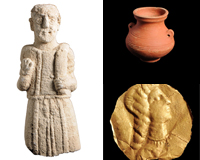Contact Center
.
18 January 2015
“Ancient Bahrain: The Power of Trade” Exhibition Still on Show until 29th March 2015


“Ancient Bahrain: The Power of Trade” exhibition showcasing Bahrain National Museum's masterpieces and rare collectibles depicting the period spanning from 2000 BC to 300 AD , which is hosted currently by Sharjah Archaeological Museum, will run until March 29 2015 as part of the emirate’s celebrations to mark its hosting of the Capital of Islamic Culture 2014. The exhibition will feature artifacts from Bahrain National Museum’s permanent collection.
Ancient Bahrain: The Power of Trade will run until March 29 next year as part of the emirate’s celebrations to mark its hosting of the Capital of Islamic Culture 2014.
The exhibition was inaugurated under the patronage of Member of the Federal Supreme Council and Sharjah Ruler Dr. Shaikh Sultan bin Mohammed Al Qasimi, in the presence of H.E Shaikha Mai Bint Mohammad Al-Khalifa, on 29th October 2014.
The event is organized by Sharjah Museums Department and coordinated by Bahrain National Museum as part of the efforts of the Culture Ministry in Bahrain to boost inter-cultural dialogue and spotlight the kingdom's rich heritage. The exhibition is being held in partnership with the Bahrain National Museum and further reinforces Sharjah’s role as 2014 Capital of Islamic Culture, and Manama’s celebrations as Capital of Asian Tourism. The show will bring magnificent artifacts from Bahrain National Museum’s permanent collection, focusing on the Dilmun civilization, dating from second millennium BC to third century AD. It represents the continued joint efforts of UAE and Bahrain to further enhance their cultural collaboration by creating opportunities for residents and visitors to explore Gulf heritage and learn more about Bahrain’s rich history. The exhibition offers the rare opportunity for visitors to explore the social and cultural domains of old Bahrain, and to further understand how the island’s exceptional geographic location in the heart of the old world made it a melting pot for numerous cultures. The well-preserved artifacts further demonstrate how local communities valued and cherished their local culture from the Dilmun civilization into the present day.
Within Sharjah Archeology Museum, the show’s exhibitions are categorized into four main sections: ‘Dilmun and Tylos: Centuries of Commerce and Prosperity’; ‘Dilmun: the Storage of the Gulf in the Bronze and Iron Ages (2000-500 BC)’; ‘Tylos: the Trade Routes Cross-Road (300-200 BC)’; and ‘Beyond Trade Influence: A Rich Local Culture.’ Around 150 artifacts on display represent Dilmun and Tylos as prosperous markets on important marine trade routes.
Artifacts from the Bahrain National Museum’s permanent collection include stone stamps, pottery, glassware, ivory and alabaster kitchen pieces, gold-work and stone. These beautifully conserved displays, dating back as early as 2050 BC, testify to the richness of trade activity in the region and Bahrain’s important role as a trade centre and site of the Dilmun civilization. The islands of Bahrain first stepped onto the stage of history some 3000 years BC as the centre of one of the great trading empires of the ancient world. This was the civilization of Dilmun -- founded during the Bronze Age and lasting in one form or another for over 2000 years. Dilmun developed as a centre of trade and commerce because of its location along the trade routes linking Mesopotamia with the Indus Valley. Its decline dates from the time the Indus Valley civilization fell in the middle of the second millennium BC. Once the decline had set in it continued over the following centuries. There is mention of Dilmun as a vassal of Assyria in the 8th century BC and by about 600 BC it had been fully incorporated into the Neo-Babylonian Empire.







